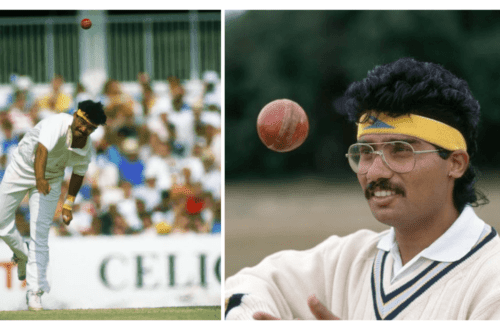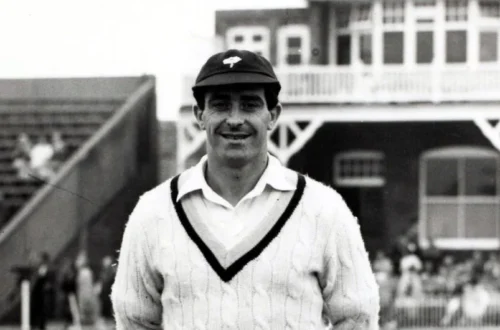
Ramakant Desai – 10 interesting facts about the Tiny Giant of Indian Cricket
Ramakant Desai was a fast bowler who defied his small stature, 5 feet 4 inches, to lead the Indian attack in the 1960s. He made his debut at the age of 19 against West Indies in 1958-59 and went on to play 28 Tests, taking 74 wickets at an average of 33.87. He was also a handy lower-order batsman, scoring 841 runs at an average of 15.38, with a highest score of 85.

Ramakant Desai was known for his courage, stamina and out-swinger. He troubled many top batsmen with his deceptive bouncer and often bowled long spells without losing his pace or accuracy. He was especially effective against Pakistan‘s Hanif Mohammad, whom he dismissed four times in nine innings in 1960-61. He also had memorable performances in England, where he took five wickets at Lord’s in 1959 and six wickets at Leeds in 1967.

Ramakant Desai Late Shri. Balasaheb Thackeray in 1959.
Ramakant Desai – 10 interesting facts
- Ramakant Desai was born on June 20, 1939 in Bombay (now Mumbai) and died on April 27, 1998 in Mumbai due to cardiac arrest. He was only 58 years old.
- Ramakant Desai made his Test debut against West Indies in 1958-59 at Delhi and took 4/169 in 49 overs. He also took five wickets in an innings for the first time at Lord’s in 1959, where he had England in trouble at 80/6.
- Ramakant Desai was nicknamed “Tiny” because he was only 5 feet 4 inches tall, but he generated enough pace and bounce to trouble the best batsmen of his era. He was also known for his deceptive out-swinger and his ability to bowl long spells.
- Ramakant Desai was the leading wicket-taker for India in the 1960-61 series against Pakistan with 21 wickets in five Tests. He also scored his highest Test score of 85 in the first Test at Bombay, adding a record 149 runs for the ninth wicket with Nana Joshi.
- Ramakant Desai’s best bowling performance in Tests was 6/56 against New Zealand at Bombay in 1964-65, where he bowled India to a seven-wicket victory. He also took six wickets in an innings twice against England, at Madras in 1961-62 and at Leeds in 1967.
- Ramakant Desai toured England twice (1959 and 1967), West Indies once (1961-62) and Australia and New Zealand once (1967-68). He played a total of 28 Tests, taking 74 wickets at an average of 33.87 and scoring 554 runs at an average of 13.75.
- Ramakant Desai showed his bravery and determination when he continued to bat after his jaw was fractured by a ball from Dick Motz at Dunedin in 1967-68. He scored 32 not out and added 57 runs for the last wicket with Bishen Bedi.
- Ramakant Desai was a prolific performer in the Ranji Trophy, where he played for Bombay from 1958-59 to 1968-69. He took a record 50 wickets in his debut season, including a match haul of 11/38 against Saurashtra.
Desai played exactly 150 First-Class matches, taking 468 wickets at an impressive 24.10. Of these,he played 53 Ranji Trophy matches for Bombay, for whomhe captured 239 wickets at a phenomenal 15.61.
He also scored his only first-class century (107) against Rajasthan in the final of 1962-63. He never finished on the losing side in his Ranji Trophy career. - Ramakant Desai announced his retirement from regular first-class cricket after the Ranji Trophy final of 1968-69, when he was only 29 years old. He was overworked and often injured due to bowling on unresponsive pitches in India and abroad. He later became the chairman of selectors from 1996 to 1997, but resigned a month before his death.
- Ramakant Desai was one of the few Indian fast bowlers who earned respect and admiration from his opponents and peers. He was praised by Sir Garfield Sobers, who called him “a great competitor”. He was also admired by Sir Frank Worrell, who said “I wish we had someone like him”.

Desai was also a pioneer of reverse swing in India, using the older ball to generate movement in the air and off the pitch. He was admired by his teammates and opponents alike for his skill, spirit and sportsmanship. He retired from international cricket in 1968 and later became a national selector and coach. He died in 1998 at the age of 58, while awaiting heart surgery.



